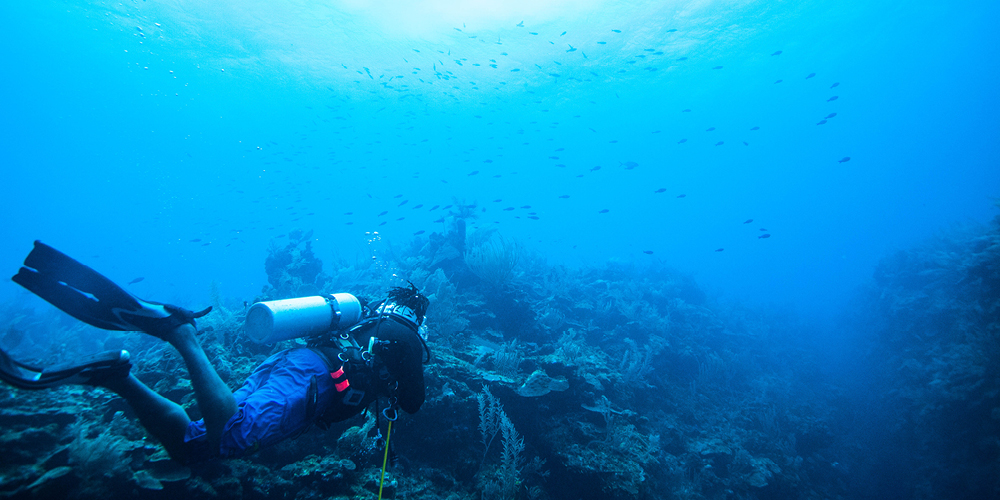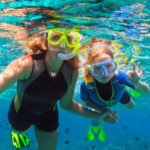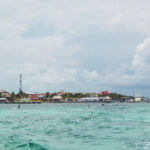Roundup of the Best Scuba Diving Sites in Belize

Sep 11, 2019
By now, you’ve probably heard the hype about scuba diving in Belize. The Belize Barrier Reef stretches the full length of the country and is peppered with hundreds of islands, or, Cayes (pronounced, “keys”). In addition to the world-class scuba diving to be found under the waves, there is much to do back on shore, as well. The combination of luxury resorts, fine dining restaurants, fun beach bars, and excellent jungle adventures on the mainland ensures that your nights and interval days will not be wasted.
With water temperatures remaining warm year-round and the protected nature of the reef, it’s possible to find a fantastic diving experience at any time of the year. Home to three different Atolls, myriad cayes and many types of coral reef habitats, the diving found in this tiny jewel of a country is not to be missed. Most sites have little-to-no current making them great for beginners. More advanced sites, like the Great Blue Hole, will take you to depths of 130 feet. Visibility is regularly upwards of 60-100 feet, giving you a great view of all the marine life to be found on the reef. We’ve rounded up the best dive sites in Belize for you, organized by location.
Ambergris Caye Local Dive Sites
Belize’s largest island is Ambergris Caye, at 25 miles long. Just a 20-minute flight from the international airport in Belize City, the island is a popular vacation destination. These sites are near the island, with boat rides from 5-25 minutes from shore. The ease of access and the wide variety of sites help Ambergris Caye stand out as a home base for your scuba diving vacation in Belize.
Chimney
Named after its resemblance to a chimney and fireplace, this dive has a swim through that opens up into a large cavern and exits at 85 feet. Highlights include vase and barrel sponges, an array of coral whips and fans, green and hawksbill turtles as well as the nurse sharks and stingrays.
Cypress Tunnels
This dive can include just the canyons which are spectacular in themselves, or you can dive slightly deeper into a tunnel through one of the canyons starting at 60 feet and exits at 75 feet, at the base of a canyon. This area is excellent for some of the macro marine life as well as large Groupers and Snappers.
Devil’s Canyons
This is a steep canyon, with a wall of 60-150 feet. Diving this wall is impressive as the drop off is quite steep as you descend. The marine life is vast here, with chances to see many species of fish, coral, and other creatures.
Eagle Ray Canyon
This site is also just outside the Hol Chan Marine Park Channel and falls under its protection. Due to tidal currents, you can often meet schools of spotted eagle rays. The reef itself is accentuated by huge barrel sponges and a variety of big groupers.
Esmerelda
The Shark and Ray Alley for divers, this has been a feeding site for over 30 years. Small sardines are placed in a bottle and released in small amounts on this dive so divers can see the nurse sharks in all their glory.
Hol Chan Marine Reserve
Hol Chan is Mayan for ‘Little Channel.” The entire reserve focuses on a cut through the reef which is little more than 25 yards wide and 30 feet deep. This is a steep channel through the reef, with all kinds of marine life.
Hol Chan Night Dive
One of the few places along the Barrier Reef suitable for night dives. Guides supply lights – marine life supplies their spectacular plumage and colors which are only viewable during night dive excursions!
Love Tunnels
If you enjoy swim-throughs, then this is the dive for you! This dive has three tunnels; two short and shallow tunnels and a finally deeper and longer tunnel. It is said that two underwater weddings have allegedly taken place here, hence the name.
M&M
The spur and groove canyons here vary in-depth, giving greater scope to the marine life visible. This dive averages between 70-90 feet. Things to look out for on this dive are the grouper and jacks as well as the pelagic such as turtles and eagle rays.
Mexico Rocks
Mexico Rocks is the newest marine protected area in Belize! The water is on average 10-12 feet deep with excellent visibility inside the reef. This area is a patch reef within the Northern Shelf Lagoon and has over 100 clusters of massive boulder corals.
Pescador Canyons
This site has a hidden tunnel through the coral, formed by the overlapping of the spur and groove formation. You will dive through the tunnel to exit at 75 feet. Keep your eyes open for some of the turtles and rays that are common here.
Pillar Coral
This is a spur-and-groove reef under the protection of Hol Chan Marine Reserve. Large schools of yellow chub, bar jacks and yellowtail snapper patrol the water above the reef. On some days, schools of more than a dozen spotted eagle rays pass through.
Tackle Box
The maximum depth on this dive can reach 100 feet where the dive opens into a wide sandy bottom of the spur and groove coral formations, here you can see the drop off into the blue. This is also where sightings of the Caribbean Reef Sharks are common, as well as Nurse Sharks, Spotted Eagle Rays and assorted Turtles.
Tres Cocos
Tres Cocos is a spur-and-groove reef with deep and locally narrow canyons running perpendicular to the reef line. If you follow the mooring line down it will lead you to a spur covered with a forest of soft corals swaying to the rhythm of the ever-present wave surge. This is the spot where the sea turtles can be seen during the mating season.
Victoria Canyons
This dive site is on the south of the island. It offers a dramatic view of the spur and groove formation and the dive can be either shallow or deep depending on your preference. There is also a swim-through for those who wish to do a deeper dive exiting at a depth of 90 feet.
Lighthouse Atoll Dive Sites
Lighthouse Atoll is home to some of the most iconic sites in Belize, including the Great Blue Hole and a nesting colony of red-footed booby birds on Half Moon Caye. A 2.5-hour boat ride from Ambergris Caye and Caye Caulker, diving day trips to the Atoll are often combined with several dive stops.
The Great Blue Hole
This iconic formation can be seen from space! See it for yourself as you descend to 130 feet in this sunken cave to see stalagmites and stalactites up to 30 feet in length! Due to the depth, the length of the dive is a maximum of 25 minutes.
Half Moon Caye Wall
Enjoy a drift dive along this spectacular wall to find Caribbean reef sharks, nurse sharks and a variety of rays. After the dive, enjoy lunch on Half Moon Caye where you can see a large colony of red-footed booby birds.
The Aquarium at Long Caye
Often the third stop of the day on a Blue Hole day trip. Highlight species include sea feathers and lace coral, as well as many macro highlights.
Placencia Dive Sites
The Placencia peninsula is located in the south on the mainland of Belize. The charming town has many resorts and beach bungalows, great dining and access to some great diving hotspots. Boat rides to dive sites tend to take a little longer as you leave from the mainland and the reef does not come close to shore on the mainland.
Coral Garden
Explore the mounds of coral with sandy patches in between where stingrays and flounder like to lay hidden. This site can be done at 40 or 70 feet, depending on your preference and experience.
Gladden Spit
During the full moon in the spring months, whale sharks can be found feeding here. Whale sharks feed at fish spawning aggregation sites and are the size of a school bus. The best chance to see them is on the days surrounding the full moon from March-June each year.
Glover’s Reef Atoll
Glover’s Reef is one of the least-visited sites due to its remote location. The trek to Glover’s Reef is definitely worth it for the rich and healthy reef systems that you encounter there. With over 700 patch reefs in the atoll, it is an official World Heritage Site, receiving funding through UNESCO.
Laughing Bird Caye National Park
Just 13 miles southeast of Placencia, this fairly new protected area offers great diving. As a shelf atoll, there are deep channels to explore when you dive here.
Long Coco Split
This site is 25-90 feet deep, between Mosquito Caye and Laughing Bird Caye. You’ll see large schools of silversides and other larger fish near the tip of the split. The reef stands out with its large numbers of black coral and gorgonians.
South Water Caye Marine Reserve Dive Sites
The South Water Caye Marine Reserve is the largest marine protected area in Belize. It covers more than 47,000 hectares of marine and mangrove ecosystems, making it an important ecological site. Due to its protected status and southern location, a bit out of the more heavily trafficked areas to the north, the diving is pristine and varied.
South Water Caye
For more upscale accommodations in the area, you can choose to stay at South Water Caye. A sandy beach is a highlight, plus great diving and snorkeling nearby. Tiny seahorses, urchins, and other creatures can often be found near the docks and in the tide pools.
Tobacco Caye
A tiny, idyllic island of just 5 acres, Tobacco Caye sits right on the reef. This is a great rustic home base for diving right from shore. A boat can facilitate a dive on the fore reef and spur & groove coral formations.
Turneffe Atoll Dive Sites
Turneffe Atoll is the largest of Belize’s atolls, being 30 miles long and 10 miles wide. It is also the closest atoll to the mainland, though the boat ride is still about 2.5 hours. Conditions permitting, three dive sites will be chosen by the divemaster to round out a day trip to Turneffe Atoll.
The Elbow
This is a wall dive known for the many pelagic species that congregate here. This site really shines during the full moon, as the currents and tide converge, bringing thousands of fish to the area.
Myrtle’s Turtle
The colorful name comes from a 100-year-old green sea turtle that has been sited here for decades and is known to be friendly with divers.
Front Porch
The steep wall here allows for a deep dive to explore the many creatures that call this place home. It is often the last dive site on a full day of diving out on Turneffe.





